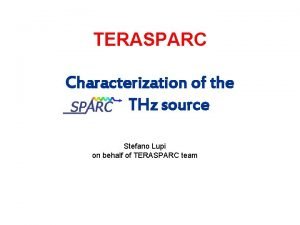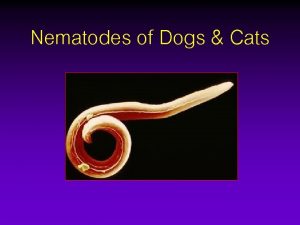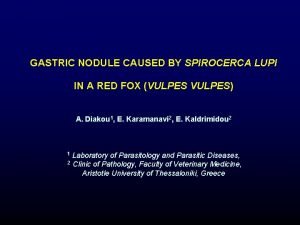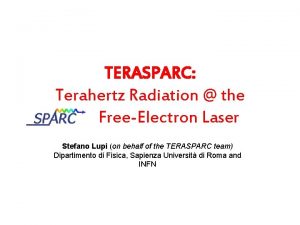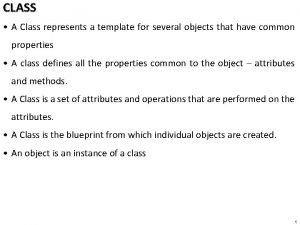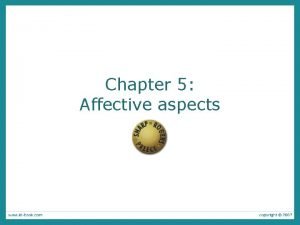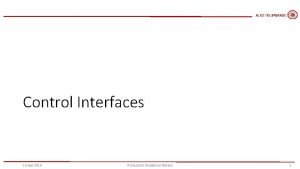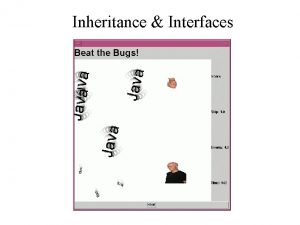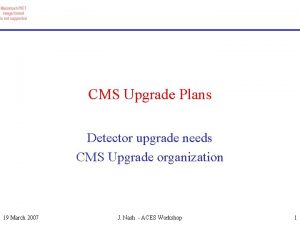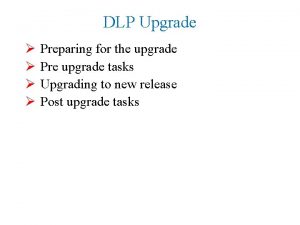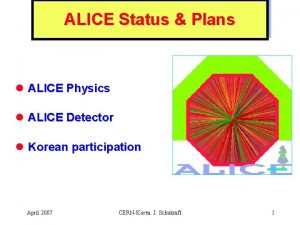ALICE ITS UPGRADE Control Interfaces Matteo Lupi matteo












![Optical Fiber Power Loss Tests Splitter Power loss Ideal splitter [d. B]1 Power loss Optical Fiber Power Loss Tests Splitter Power loss Ideal splitter [d. B]1 Power loss](https://slidetodoc.com/presentation_image_h2/413f6e315061a948a5656bb2a4cef620/image-13.jpg)
- Slides: 13

ALICE ITS UPGRADE Control Interfaces Matteo Lupi (matteo. lupi@cern. ch) 13 -Apr-2018 Production Readyness Review 1

Detector Control System (DCS) Paths ALICE ITS UPGRADE Readout Unit FLASH FPGA PROASIC 3 FLASH PROM SUPPLY SENSE TEMP SENSE CANBUS I 2 C POWER UNIT DCTRL DETECTOR SENSORS USB 3 13 -Apr-2018 I 2 C FX 3 SRAM FPGA XILINX ULTRASCALE SCA GBTx 0 VTRX CRU / O 2 FLP GBTx 1 VTTX GBTx 2 VTRX Production Readyness Review LTU/ CTP 2

Control Interface (SRAM-based FPGA) ALICE ITS UPGRADE FPGA 16 bit Data 15 bit Address 1 bit R/W . . 32 bit Wishbone Master FIFO 32 bit Wishbone Slave 2 Wishbone Bus Wishbone Slave 1 Control Interface Wishbone Bus Structure Wishbone Slave n Optional 13 -Apr-2018 Production Readyness Review 3

Controls Protocol • • Based originally on 32 bit USB words sent over FX 3 DCS -> FPGA • Write Request: 31 24 W/R=1 Module Addr[6: 0] • 16 Reg Addr[7: 0] 0 Data[15: 0] Read Request: 31 24 W/R=0 Module Addr[6: 0] • ALICE ITS UPGRADE 16 Reg Addr[7: 0] 0 Don’t Care[15: 0] FPGA -> DCS • Write Response: None (no acknowledgement, but errors are kept in a wishbone slave register – associated with the wishbone master for possible later interrogation) • Read Response: Errors are kept in a wishbone slave register – associated with the wishbone master - for possible later interrogation 31 Error 13 -Apr-2018 24 Module Addr[6: 0] 16 Reg Addr[7: 0] Production Readyness Review 0 Data Response[15: 0] 4

GBTx Controls Transactions ALICE ITS UPGRADE GBTx – SWT: Single Word Transaction 79 75 SWT 0 Transaction Parameters DV 0 No problem on downstream path: Only kind of communication Upstream path: SWT interspersed between data packets 13 -Apr-2018 Production Readyness Review 5

GBT Control Protocol ALICE ITS UPGRADE Use CRU protocol “Single Word Transactions” (SWT) as a means for both downlink and uplink of control information Every Controls transaction described in previous slides maps exactly to one SWT GBT word For radiation testing purposes, we implemented SWT words containing duplicated USB packets Downstream and Upstream GBTx words have the same format: • • – Downstream GBTx words contain request packets to the wishbone bus – Upstream GBTx words contain response packets from the wishbone bus DV 0 76 SWT (0 x 3) 64 Packet Ctr (12 b) 32 Reserved 0 Control Word (32 bit) 80 bit GBTx word + Data Valid (DV) • • A Python module for interacting with the CRU “SWT handler” using the above protocol was developed based on the O 2 Python module “lib. Readout. Card” The User Interface of this “SWT” module are the following functions: – clear. Fifos(): – write(module, address, data): – read(module, address): 13 -Apr-2018 Clear the SWT FIFOs in the firmware Write “data” to module “module” at register address “address” Read register “address” in module “module” Production Readyness Review 6

CANbus Controls Transactions ALICE ITS UPGRADE • CANbus Opencores controller for raw packets • High-Level-Protocol (HLP) on top of controller to define a node based communication interface and to define simple READ and WRITE transactions & responses with appropriate payload • Interface to wishbone bus same as GBTx: • Input & Output FIFOs • Wishbone Master for transactions on bus • WB slave interface in controller to configure protocol parameters like baud-rate and filters Electrical pass-through Emulate a “network topology”: Divide 11 -bit CAN ID field into a “Node ID” and a “Command” field: Msg. ID[10: 4] Msg. ID[3: 0] ID[10] N[6] ID[9] N[5] ID[8] N[4] ID[7] N[3] = N[6: 0] = C[3: 0] ID[6] N[2] ID[5] N[1] = Node. ID = Command (read, write, read_response, write_response) ID[4] N[0] ID[3] C[3] Allows for up to 128 nodes per CAN network 13 -Apr-2018 ID[2] C[2] ID[1] C[1] ID[0] C[0] Production Readyness Review 7

CANbus Test Setup • • • ALICE ITS UPGRADE Anagate “CAN Quattro” CAN controller Opencores “Project CAN” protocol controller Wishbone interface to PA 3 firmware for configuration Configured for 1 Mbps baud rate (highest possible for CANbus) “CAN Monitor” from Anagate to generate and receive standard and extended ID CAN packets with up to 8 bytes payload 13 -Apr-2018 Production Readyness Review 8

ALPIDE Control Implementation ALICE ITS UPGRADE Physical Implementation FPGA design logic 13 -Apr-2018 Production Readyness Review 9

Power Board – Interface to Readout Unit ALICE ITS UPGRADE • Two 8 -channel Power Units are combined into one board stack called a “Power Board”. • Each Power Unit provides power for up to 8 modules (16 per Power Board) • In layers 5 & 6 each Power Board provides power for one full stave (one power unit per half-stave) • In all other layers, each Power Unit provides power for one stave, so there are 2 staves per Power Board • Each Power Unit is interfaced to a Readout Unit via 2 (differential) I 2 C buses, with multiple devices per bus • Each Power Board consisting of 2 Power Units therefore has a total of four I 2 C buses • In layers 5 & 6, each Power Board interfaces to one Readout Unit (a total of four I 2 C buses per Readout Unit) • In all other layers, each Power Unit interfaces to one Readout Unit (a total of two I 2 C buses per Readout Unit) • Control via two I 2 C wishbone slaves (one per Power Unit) allows setting and monitoring voltages, currents, temperature thresholds and power status Outer Layer Configuration 13 -Apr-2018 Middle Layer Configuration Production Readyness Review 10

Power Board – Readout Unit Pairing Outer Layers I 2 C Middle Layers I 2 C 13 -Apr-2018 I 2 C Production Readyness Review Inner Layers I 2 C ALICE ITS UPGRADE I 2 C 11

Trigger Interface – Optical Splitting The Central Trigger Processor (CTP) directly drives a set of Local Trigger Units (LTUs), each responsible for delivering the trigger to a specific detector. • ITS will have its own LTU • ITS LTU will drive 12 (or 6) Single Mode, 1030 nm SFP+ Modules. Low radiation area Mini-frame ITS Readout Unit optical Sensor copper optical Passive optical splitting 1: 16 (1: 32 also possible) ALICE ITS UPGRADE 16× Up to 28× • Each optical line is split into 16/32 lines by a passive optical splitter, which can withstand the foreseen TID level (10 k. Rad) and does not suffer from SEU. • As each LTU has 12 optical drivers, a 1: 16 splitting ratio (at least) will be ok 12× 13 -Apr-2018 Production Readyness Review 12
![Optical Fiber Power Loss Tests Splitter Power loss Ideal splitter d B1 Power loss Optical Fiber Power Loss Tests Splitter Power loss Ideal splitter [d. B]1 Power loss](https://slidetodoc.com/presentation_image_h2/413f6e315061a948a5656bb2a4cef620/image-13.jpg)
Optical Fiber Power Loss Tests Splitter Power loss Ideal splitter [d. B]1 Power loss Margin [d. B]2 Measured [d. B] 1: 2 splitter 3 3. 686 16. 689 1: 4 splitter 6 6. 838 13. 539 1: 8 splitter 9 10. 535 9. 841 1: 16 splitter 12 14. 333 6. 044 1: 32 splitter 15 16. 359 4. 983 The numbers for ideal power loss is taken from http: //www. thefoa. org/tech/ref/testing/test/couplers. html 2 Margin is given based on: 1 - the Avago AFCT-57 D 3 ANMZ transmitter (optical power output +5 d. Bm) - the VTRx sensitivity (-15. 376 d. Bm) Fiber optics association: http: //www. thefoa. org/tech/lossbudg. htm 3 • As a general rule, the link loss margin should be greater than approximately 3 d. B to allow for link degradation over time 3. • The dynamic range for the chosen Transmitter & Receiver is about 20 d. B – • ALICE ITS UPGRADE The LTU has been verified to support the powerful Avago AFCT-57 D 3 ANMZ transmitter. The power tests shows that all topologies have a margin > 3 d. B – This is in line with the specifications given by the manufacturer of the splitter 13 -Apr-2018 Production Readyness Review 13
 Stefano lupi
Stefano lupi Caregirlz
Caregirlz Physaloptera life cycle
Physaloptera life cycle Spirocerca lupi
Spirocerca lupi Stefano lupi sapienza
Stefano lupi sapienza Bacovianismul
Bacovianismul Expressive interface
Expressive interface Characteristics of web interface
Characteristics of web interface Uml interfaces are used to:
Uml interfaces are used to: Industrial interfaces
Industrial interfaces What is difference between abstract class and interface
What is difference between abstract class and interface Difference between abstract classes and interfaces
Difference between abstract classes and interfaces Expressive interface
Expressive interface Dialogues
Dialogues
